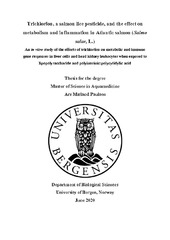Trichlorfon, a salmon lice pesticide, and the effect on metabolism and inflammation in Atlantic salmon (Salmo salar, L.)
Master thesis
Permanent lenke
https://hdl.handle.net/1956/22989Utgivelsesdato
2020-06-26Metadata
Vis full innførselSamlinger
- Master theses [267]
Sammendrag
Since the beginning of the salmon farming industry in Norway, the substantial fish health and welfare and economic costs caused by the parasitic salmon lice (Lepeophtheirus salmonis) has increased in tandem with the expanding production of salmon. In 1974, the first reported attempt at repelling the parasite was performed with the organophosphorus pesticide (OPP) trichlorfon (TCF). As L. salmonis established itself as one of the biggest biological challenges of commercial aquaculture industry, the quantitative use of pharmaceutical treatments used against salmon lice has escalated and proven to negatively affect both non-target species and the treated fish itself. In this study, isolated liver cells and head kidney (HK) leukocytes of 11 Atlantic salmon (Salmo salar, L.) post-smolts were exposed to TCF in concentrations of 25, 10 and 1 µM (1.3, 0.5 and 0.25 µL) for 48 hours and 100 µg/mL lipopolysaccharide (LPS) and 50 µg/mL polyinosinic:polycytidylic acid (poly I:C) for 24 hours in vitro, to examine the toxic effects of TCF and if it affects metabolic or immunogenic responses when under simulated bacterial (LPS) and viral (poly I:C) infection. Untreated cultures were included as controls. Transcription of the inflammatory markers CD83 and Cox-2 in isolated liver cells and HK leukocytes in addition to inflammatory markers IL-1β and TNF α in leukocytes, was significantly affected by LPS, further verifying the suitability of the in vitro model used in this experiment. Expression of the immunorelated metabolic genes was not significantly affected by any treatment. The gene expression of the oxidative stress (OS) related gene Bcl-2 was down regulated in leukocytes by poly I:C alone and poly I:C with TCF. Similarly, gene expression of the apoptotic related gene caspase3 was significantly upregulated in leukocytes cultured with poly I:C, suggesting an antiviral involvement. The expression of antiviral response genes Mx, significantly elevated in leukocytes by poly I:C, and viperin, significantly induced in both liver cells and leukocytes by poly I:C, confirms their role in the antiviral immune response of S. salar. No genes in this study were significantly affected by TCF. This study solidifies application of this in vitro model in observing effects of LPS and poly I:C on specific metabolic and inflammatory related genes in Atlantic salmon. While not confirming the toxic effects of TCF on S. salar and subsequently, non-target organisms, this study could be viewed as an indicator of the toxicity of TCF.
Utgiver
The University of BergenOpphavsrett
Copyright the Author. All rights reservedBeslektede innførsler
Viser innførsler beslektet ved tittel, forfatter og emneord.
-
Salmon economic analysis: an operational cost study, finding better ways to ensure efficient resource utilization, improves profitability and environmental sustainability for the salmon aquaculture in Norway.
Alam, Md Fazla Rabbi (Master thesis, 2018-12-20)Salmon aquaculture is the fastest growing industry in Norway, contributing to food security and nutrition. The industry ensures social, economic and environmentally sustainable development by utilizing natural resources ... -
Gene expression analyses of immune responses in Atlantic salmon during early stages of infection by salmon louse (Lepeophtheirus salmonis) revealed bi-phasic responses coinciding with the copepod-chalimus transition
Tadiso, Tariku Markos; Krasnov, Aleksei; Skugor, Stanko; Afanasyev, Sergey; Hordvik, Ivar; Nilsen, Frank (Peer reviewed; Journal article, 2011-03-07)The salmon louse (Lepeophtheirus salmonis Krøyer), an ectoparasitic copepod with a complex life cycle causes significant losses in salmon aquaculture. Pesticide treatments against the parasite raise environmental concerns ... -
Surface environment modification in Atlantic salmon sea-cages: Effects on amoebic gill disease, salmon lice, growth and welfare
Wright, Daniel William; Geitung, Lena; Karlsbakk, Egil; Stien, Lars Helge; Dempster, Timothy David; Oldham, Tina; Nola, Velimir; Oppedal, Frode (Peer reviewed; Journal article, 2018)Surface environment modification is a potential parasite control strategy in Atlantic salmon sea-cage farming. For instance, a temporary low salinity surface layer in commercial-scale snorkel sea-cages has coincided with ...
